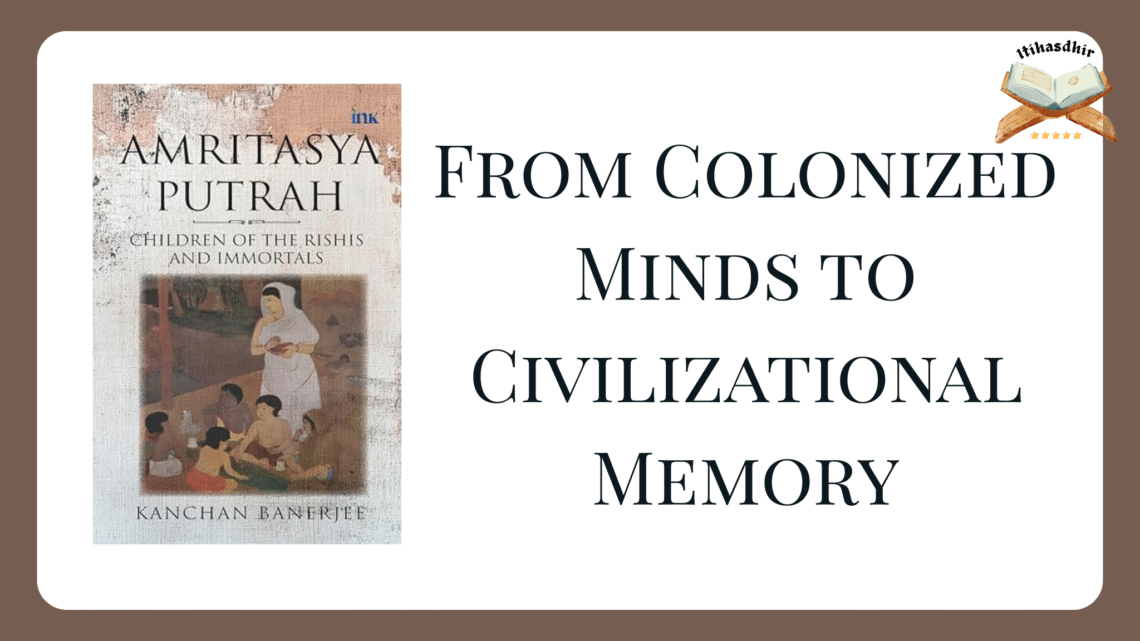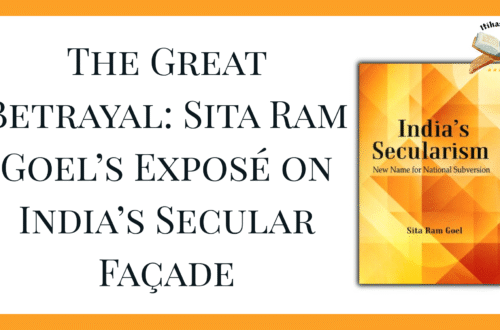
A Civilizational Manifesto: Reading Amritasya Putrah by Kanchan Banerjee
In an era marked by cultural amnesia and spiritual disorientation, Amritasya Putrah by Kanchan Banerjee arrives not merely as a book, but as a civilizational invocation, a reminder that India is not merely a geopolitical construct but a living, breathing samskriti, whose soul has been nourished for millennia by the chants of the Vedas, the wisdom of the Upanishads, and the tapasya of countless rishis. The title, drawn from the Upanishadic mahāvākya, “Shrinwantu vishwe amritasya putrah” (“Listen, O Children of Immortality”), is not a poetic flourish, but a call to reawaken the sacred identity that lies dormant beneath centuries of conquest, colonization, and confusion.
Banerjee does not write as a detached observer or a neutral chronicler; he writes as one aflame with the urgency of civilizational continuity. Amritasya Putrah is a work of cultural recovery and spiritual reclamation. It seeks to resurrect not just knowledge systems, but the very metaphysical frameworks that once anchored the Indian worldview. Banerjee’s central claim is that Bharat cannot be understood, revitalized, or even governed through the prisms of Western epistemology or modern secularism. Instead, the reclamation of India’s future must begin with a return to the ātmic center, a psycho-spiritual and cultural renaissance rooted in the civilizational consciousness of Sanatana Dharma.
Civilizational Consciousness: Six Pillars of Bharatiyata
At the heart of Banerjee’s thesis lies the assertion that India, or Bharat, is not a nation in the modern European sense, but a civilizational continuum, one whose coherence is sustained not by territorial boundaries or institutional frameworks, but by Dharma, shraddha, and an unbroken chain of transmitted wisdom. The author foregrounds what he refers to as six civilizational pillars, rooted in Vedic and Itihasic literature, that define the essence of Bharatiya existence. Though not rigidly codified, these principles include rta (cosmic order), dharma (righteous duty), atmabodha (self-realization), parampara (lineage of knowledge), guru-shishya transmission, and the pursuit of moksha (liberation) as the highest goal of life.
Banerjee’s treatment of these themes is not antiquarian. He does not merely excavate them from dusty pasts; he reanimates them as guiding forces for a society adrift in materialism and moral relativism. Through these pillars, Banerjee offers a model of human flourishing radically different from the utilitarian paradigms of the West, one that centers not on consumption, rights, or pleasure, but on transcendence, duty, and harmony with the cosmos.
Coloniality and the Crisis of the Indian Psyche
One of the most compelling sections of Amritasya Putrah is its sustained engagement with the psychological and epistemic damage wrought by colonialism, particularly the internalized inferiority that has deformed the post-Independence Indian elite. Banerjee argues that British colonial rule did not merely extract wealth and impose alien laws; it waged a systematic war against the Hindu civilizational consciousness. This war was waged through the reconfiguration of education, the erasure of indigenous epistemes, and the introduction of Eurocentric historical and moral frameworks that rendered the native worldview illegitimate.
In Banerjee’s analysis, Nehruvian secularism, Macaulayan education, and postcolonial Marxist historiography are not mere political choices, they are continuations of coloniality by other means. What resulted, he contends, is a deracinated Indian elite, ashamed of its own roots, fluent in borrowed categories, and emotionally dependent on Western validation. The psychic dislocation of modern India, according to Banerjee, cannot be remedied by economic growth or technological advancement. It requires a manasik kranti, a psychological and cultural revolution grounded in dharma.
From Cultural Revival to Spiritual Reorientation
Unlike many cultural nationalists who limit their critique to politics, Banerjee places the onus of regeneration on the individual soul. He insists that true civilizational resurgence cannot be externally engineered; it must arise from the antahkarana, the inner instrument of thought, feeling, and will. This is perhaps the most radical aspect of the book: its framing of national transformation as a byproduct of personal sādhanā. Through sustained engagement with scriptural texts, yogic disciplines, and ethical living, the individual becomes a bearer of civilizational continuity.
In this sense, Amritasya Putrah is not merely an ideological treatise but a spiritual manual. It is a call to those who consider themselves inheritors of Bharatiyata to live it consciously, through swarajya (self-rule), swadharma, and swabhava (one’s innate nature). It is here that Banerjee’s vision departs most significantly from both secular progressivism and reactive nationalism: it calls not for political conquest or cultural pride, but for adhyatmic responsibility.
Literary Style and Intellectual Contribution
Banerjee’s prose oscillates between the poetic and the polemical. He writes with intensity, often invoking metaphors from Vedic lore, epic narrative, and Puranic symbolism. At times, the structure of the book appears nonlinear, even meditative, a deliberate choice, perhaps, to reflect the shruti-like cadence of its content. While the work does not conform to the strict formalities of academic referencing, it is intellectually rigorous and textually grounded, with implicit citations from the Upanishads, Bhagavad Gita, Mahabharata, and Dharmashastras.
What Banerjee offers, then, is not a conventional academic monograph but a work of civilizational thought, akin to the writings of Sri Aurobindo, Dharampal, or Ram Swarup. It belongs to the tradition of those who sought not just to interpret India, but to restore her soul. In this sense, the book stands as both critique and prophecy, a searing diagnosis of India’s spiritual malaise, and an audacious vision for her future.
Critique and Limitations
The book’s greatest strength, its philosophical and spiritual depth, may also pose a challenge for certain readers. Those expecting a linear narrative, data-driven analysis, or a purely political manifesto may find themselves disoriented. The absence of academic citations and engagement with counter-positions might invite criticism from those trained in formal scholarship. Yet this is a deliberate stylistic and epistemic choice. Banerjee is not writing within the academic-industrial complex; he is addressing the atma of the Indian seeker, not the peer-reviewed journal.
One might also argue that the solutions offered, rooted in self-transformation and inner clarity, place too much burden on the individual in the face of systemic challenges. However, Banerjee would likely respond that without inner transformation, external change is not only futile but potentially corrosive.
Final Verdict
Amritasya Putrah is a powerful, provocative, and necessary work, one that speaks across generations to a civilization caught between remembrance and forgetting. In a time when India is being pulled in a thousand directions, toward hypermodernity, cultural fragmentation, and historical erasure, Banerjee’s book offers an axis mundi, a still center from which to reimagine the future.
This is not merely a book to be read; it is a text to be contemplated, internalized, and lived. In reclaiming the memory of being children of immortality, Banerjee invites the reader to step beyond the binary of tradition and modernity, and to inhabit once again the civilizational dharma that has always been India’s truest self.

Aditi Joshi founded Itihasdhir in 2023. She facilitates discussions on Indian history and the influence of historians. Currently, Aditi is a contributor of the VHPA initiative Stop HinduDvesha and serves as an Editor at Garuda Prakashan. A history graduate and folklore enthusiast, she is also an artist and translator, blending creativity and research to illuminate India’s cultural richness.





